Søraust-Svalbard's wildlifeBy Øystein Overrein (ed.), Jørn Henriksen, Bjørn Fossli Johansen, Kristin PrestvoldWildlife on the islands of the Søraust-Svalbard Nature Reserve is dependent on basic conditions determined by the bedrock, local climate and vegetation. The sea around the islands is dominated by cold, Arctic water. In contrast to western Spitsbergen the east is scarcely influenced by the Gulf Stream’s northern branches. This is why there is much drift ice around for most of the year. This could change with climate change.
You can register your observations of marine mammals around Svalbard in the Norwegian Polar Institute’s database Marine Mammals Sightings. 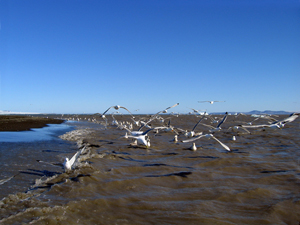
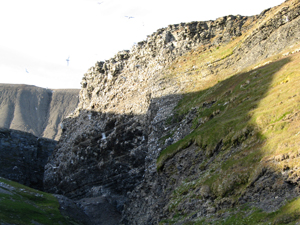
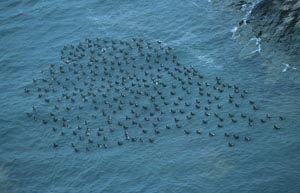
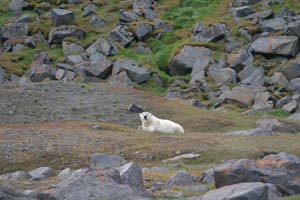
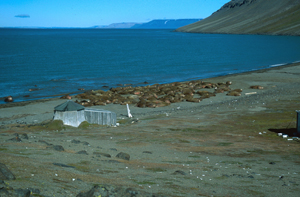
Northern fulmars breed on several localities. The two largest colonies are Kvalpyntfjellet and Negerpynten in the south-west of Edgeøya. These are also important areas for black-legged kittiwakes, Brünnich’s guillemots, black guillemots and little auks. Barnacle geese nest on several locations in Freemansundet, Andréetangen and Tusenøyane. As for the pink-footed geese, the main area for breeding is on several locations in Freemansundet, on Bjørnholmane and on islands by Andréetangen. In Svalbard. In Svalbard, brent geese have their main area for breeding in Tusenøyane. Tusenøyane is also an important breeding area for eiders. They also breed on the islands of Zieglerøya, Delitschøya and Ryke Yseøyane. Glaucous gulls breed near bird cliffs in about 20 different locations. Black-legged kittiwakes are well-represented in the Søraust-Svalbard Nature Reserve, there are 21 colonies in total, many of which are large. The kittiwakes also breed on Ryke Yseøyane and in nine colonies on Barentsøya. Only two breeding colonies for ivory gulls are known. The Arctic tern breeds in 22 places in total. Tusenøyane is the most important Arctic tern breeding area in the reserve, although Arctic terns can also be found on Ryke Yseøyane, Halvmåneøya, Zieglerøya and Delitschøya. Little auks can be found in many places and breed in a large number of colonies. Within the reserve there are four large colonies of Brünnich’s guillemots, the largest of which is on Negerpynten. Brünnich’s guillemots also breed in Vogelberget, Kvalpyntfjellet and between Russebukta and Diskobukta. Black guillemots breed all around the reserve, and in total there are 25 known colonies, of which Kvalpyntfjellet is the largest. The red-throated diver is a common bird in most of the lakes and inlets in the reserve.The pomarine skua is also a common sight in the reserve. Early in the autumn large flocks of geese graze in the valleys on Edgeøya before migrating southwards. The west of Barentsøya and Edgeøya are important moulting and feeding grounds for common eiders, king eiders and geese. Thousands of eiders can be seen in the lagoon Tjuvfjordlaguna, among other places, during the moulting season. Polar bears can be seen anywhere in the nature reserve, at any time of the year. During the winter the bears are undisturbed as there are hardly any visitors to the reserve except in the summer. Both Edgeøya and Barentsøya are vital denning areas. How many polar bears are around in the summer season depends on the amount and condition of the ice and the access to food. However, there are always polar bears present here in the summer. They can often be found on the islands with breeding seabirds or close to the bird cliffs. Female polar bears with cubs often stay in the valleys far from the coastline, where the chances of meeting adult males are smaller. Other marine mammals in the area include ringed seals, bearded seals, walrus, minke whales and white whales. Many of the most important walrus haul-out sites occur within the nature reserve. Piles of old walrus bones bear witness to the fact that these sites have been known to humans for a long time. At most of the haul-out sites there are only males. But in later years, alongside an increase in the population, females with calves have also started coming to the haul-out sites in Tusenøyane. Females and calves are vulnerable to disturbance by visitors: people should keep their distance. The most famous and most visited haul-out site is Kapp Lee in the north-west of Edgeøya. Many haul-out sites in Tusenøyane are also known, but there is no frequency of tourists here because of shallow waters that are difficult to navigate. This island region with surrounding waters are now closed to all traffic during the period 15 May to 15 August. The number of reindeer in this area is relatively large, especially on Edgeøya. This is reflected in the fertilized vegetation. The reindeer population here is protected and their abundance is controlled by the winter climate pasture and winter mortality. At the turn of the century the population on Barentsøya was estimated at about 450 animals. There were an estimated 2500 reindeer on Edgeøya, but this number is uncertain. Arctic foxes can be seen in most places in the area. The population is thought to be good because of the stable source of nutrition in seabirds and reindeer (carcasses). There is only one lake in the Søraust-Svalbard Nature Reserve where Arctic char occur. It is located in the north of Barentsøya. It is illegal to fish for char within the reserve. Updated June 2015 |
The Cruise Handbook is also available in book formHard cover with numerous pictures - 249 pages - NOK 249.00 Norwegian Polar Institute |
 Norsk
Norsk